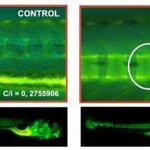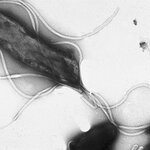Microbiology

This sounds a bit like a Dalek invasion. But in fact it’s research from Arizona State University:
X-ray laser helps slay parasite that causes sleeping sickness
Does that mean we will have people marching round the Serengeti with hi-tech equipment, blasting tsetse-flies with intense X-ray beams? It would make a good documentary TV programme, but it’s a lot less direct than that.
It has always been difficult to examine biological systems in atomic detail using direct methods. Atomic definition requires high energies, either from electrons in an electron microscope or X-rays…

Bacteria exposed to antibiotics for long periods find ways to resist the drugs — by quickly pumping them out of their cells, for example, or modifying the compounds so they're no longer toxic.
New research has uncovered another possible mechanism of antibiotic "resistance" in soil - a soil bacterium that breaks down the common veterinary antibiotic, sulfamethazine, and uses it for growth. Certain soil bacteria are already known to live off, or "eat," agricultural pesticides and herbicides, says the study's leader, Ed Topp, a soil microbiologist with Agriculture and Agri-Food Canada in London…

Toxoplasmosis is caused by the Toxoplasma gondii parasite, which experts estimate infects 30 to 50 percent of the global population.
The infection is also found in animals, especially domestic cats and people contract the parasite mostly by eating the poorly cooked flesh of infected animals or through contact with cat feces. The infection causes mild flu-like symptoms in adults and otherwise healthy people before entering a chronic and dormant phase, which has previously been regarded as symptom-free. It is, however, known that toxoplasmosis in the brain can be fatal in people with…

Probiotics are the miracle product of the decade because of the belief they can help cultivate “intestinal flora”, whatever that is supposed to mean. It's a $32 billion industry by 2014 but there is one species that scientists can confirm have a benefit - zebrafish.
The Institute of Marine and Environmental Technology found that feeding probiotics to baby zebrafish accelerated their development and increased their chances of survival into adulthood.
Zebrafish are often used in genetic research because they grow quickly and scientists can easily track changes in their development. They…

Researchers have discovered that a virus commonly found in dogs may lead to a breakthrough in human vaccine development.
Parainfluenza virus 5, or PIV5, is harmless to humans but is thought to contribute to upper respiratory infections in dogs, and is a common target for canine vaccines designed to prevent kennel cough. In a new paper, researchers describe how this virus could be used in humans to protect against diseases that have eluded vaccine efforts so far.
Because PIV5 does not cause disease in humans but our immune system recognizes and destroys it, antigens from other viruses or…

A community of bacteria that survives in a dark, salty and sub-freezing environment has been discovered beneath nearly 20 meters of ice in one of Antarctica's most isolated lakes.
Lake Vida, the largest of several unique lakes found in the McMurdo Dry Valleys, contains no oxygen, is mostly frozen and possesses the highest nitrous oxide levels of any natural water body on Earth. A briny liquid that is approximately six times saltier than seawater percolates throughout the icy environment that has an average temperature of minus 8 degrees Fahrenheit.
Despite the very cold, dark and isolated…

Microbiologists and geochemists have shown that marine methane oxidation coupled to sulfate respiration can be performed by a single microorganism, a member of the ancient kingdom of the Archaea, and doesn't need to be carried out in collaboration with a bacterium, as previously thought.
Vast amounts of methane are stored under the ocean floor. Anaerobic oxidation of methane coupled to sulfate respiration (AOM) prevents the release of this potent greenhouse gas into the atmosphere. Although the process was discovered 35 years ago it has remained a mystery how microorganisms perform this…

Researchers have discovered bacteria that transmit electrons thousands of cell lengths away.
The Desulfobulbus bacterial cells, which are only a few thousandths of a millimeter long, are so tiny that they are invisible to the naked eye. And yet, under the right circumstances, they form a multicellular filament that can transmit electrons across a distance as large as 1 centimeter as part of the filament's respiration and ingestion processes. They are living power cables.
The team studied bacteria living in marine sediments that power themselves by oxidizing hydrogen sulfide. Cells at the…

Helicobacter is a good example in our changing understanding of the role of microbes and the human body environment. Some may recall that this particular bacteria was introduced to the public in a rather striking experiment where it was suspected of causing stomach ulcers and gastritis. Dr. Barry Marshall drank a petri dish containing cultured Helicobacter Pylori and within days developed gastritis. This demonstrated a firm connection between bacteria and gastritis/stomach ulcers as well as the role of using antibiotics to treat this condition.
Helicobacter is presumed to be…

People love Top 10 Lists. So a ranking system of the ten most important phytopathogenic fungi on a scientific and economic level should be a big hit. If you don't want to spend five more minutes reading, the rice blast fungus (Magnaporthe oryzae) is at the top of the list.
The results were tabulated by a survey of 495 international researchers about the most important phytopathogenic fungi. Each researcher chose three that they thought to be most significant and the most voted then formed the list.Dr. Antonio Di Pietro from the department of genetics in the University of Cordoba…